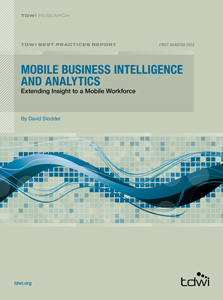
Mobile Business Intelligence and Analytics: Executive Summary
TDWI's new Best Practices Report dives deep into the benefits, challenges, data management issues, and recommendations for mobile business intelligence and analytics.
- By David Stodder
- December 28, 2011
Extending Insight to a Mobile Workforce
 Look up Apple iPads or other tablet computers on any consumer electronics Web site and you will see that the marketing is all about consumer desires: video calling, gaming, watching movies in high definition, or browsing the Web. Left unsaid is what these mobile devices, as well as smartphones, could do for the experience of consuming, sharing, and interacting with business data. Excitement is growing among business users about how they could use mobile devices to transform the role of information in customer interactions, performance management, planning and forecasting, and their daily operational decisions while on the go.
Look up Apple iPads or other tablet computers on any consumer electronics Web site and you will see that the marketing is all about consumer desires: video calling, gaming, watching movies in high definition, or browsing the Web. Left unsaid is what these mobile devices, as well as smartphones, could do for the experience of consuming, sharing, and interacting with business data. Excitement is growing among business users about how they could use mobile devices to transform the role of information in customer interactions, performance management, planning and forecasting, and their daily operational decisions while on the go.
BI tools and applications are critical if mobile devices are to live up to their potential in the workplace. However, the pairing is not an easy one. Mobile devices are cool, glitzy, and fun. Consumers select and buy devices of choice; they can download applications as they please from app stores or access them through Web browsers. They get to shape how they use devices in a personalized fashion. Historically, BI systems have been the opposite. Rather than aim for fun and personal choice, BI systems have focused on providing users with repeatable analysis and high-quality, consistent data and reports. Recent tool releases have given users more self-service opportunities and data visualization choices; however, IT’s performance, cost, security, and other constraints allow personalization to go only so far—certainly not as far as with consumer uses of the devices.
The prospect of rolling out enterprise-class BI and analytics on mobile consumer devices gets IT managers excited—but not necessarily in a good way. Data security is a major concern, as is adherence to regulations that threaten punishment if personally identifiable information (PII) and other sensitive data are exposed. Data security with mobile BI may not be as scary as business and IT managers initially fear, but security concerns are still among the chief barriers to deploying BI and analytics on mobile devices. Meeting expectations for performance and availability could prove to be tougher challenges, particularly as interest in real-time data rises.
IT executives, managers, and BI directors do get excited about any technology that can increase opportunities to deliver the right data to the right users at the right time: the credo of BI. Because they make it less relevant where and when users can interact with data and receive alerts about changes and trends that impact their responsibilities, mobile devices can bring organizations closer to the realization of “right data, right users, right time” objectives that are behind most BI deployments.
What’s critical, however, is to enable BI and analytics to thrive by making best use of what is “insanely great” about mobile devices (to borrow late Apple cofounder and CEO Steve Jobs’s famous expression). Many of the touch, content-interaction, and collaboration features that make tablets and smartphones so appealing for consumer use could also revolutionize the experience of BI, particularly for nontechnical users.
This report examines the impact of mobile computing on the development, management, and implementation of applications and services for BI and analytics. The report will interpret the results of an extensive survey about organizations’ current experiences and plans for future deployment of mobile BI and analytics for users ranging from executives to frontline sales, service, and support personnel. It will also explore the types of functionality most important to users on the go, and the challenges that IT data management must address to support mobile users’ functionality requirements. The report will recommend best practices for organizations that are planning to deploy BI and analytics applications and Web browser–based services on mobile devices.
Birst, Information Builders, MicroStrategy, SAP, and Tableau Software sponsored the research for this report.
About the Author
David Stodder David Stodder is an independent data and analytics industry analyst. Previously, he was senior director of research for business intelligence at TDWI, where he spent more than 13 years. Stodder focuses on providing research-based insights and best practices for organizations implementing BI, analytics, AI, data intelligence, data integration, and data management. He has been a thought leader in the field for over three decades as an industry analyst, writer, and speaker. He was the founding chief editor of Intelligent Enterprise where he also served as editorial director for nine years. Stodder is a TDWI research fellow.